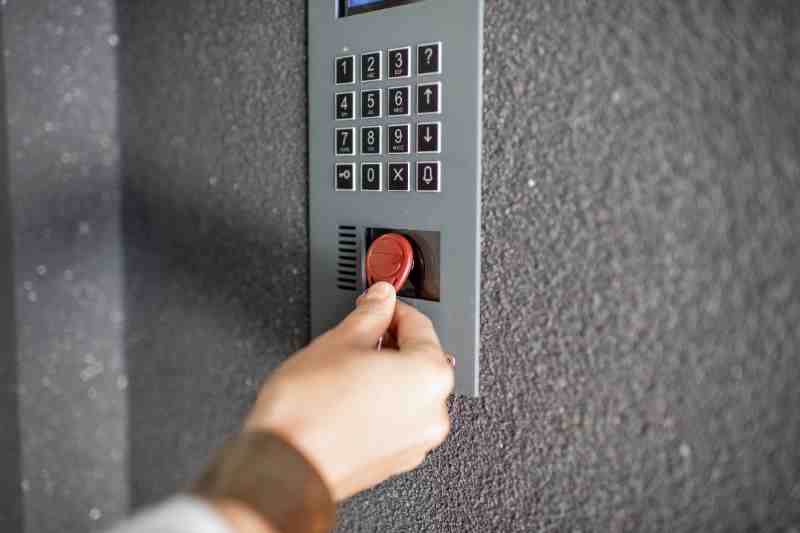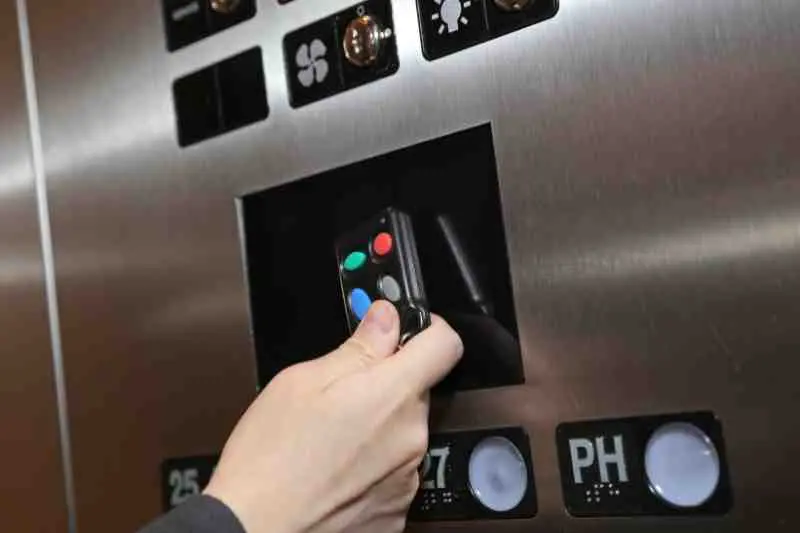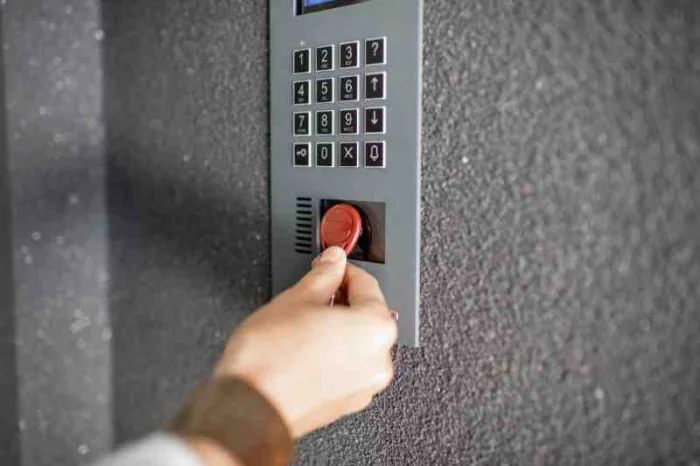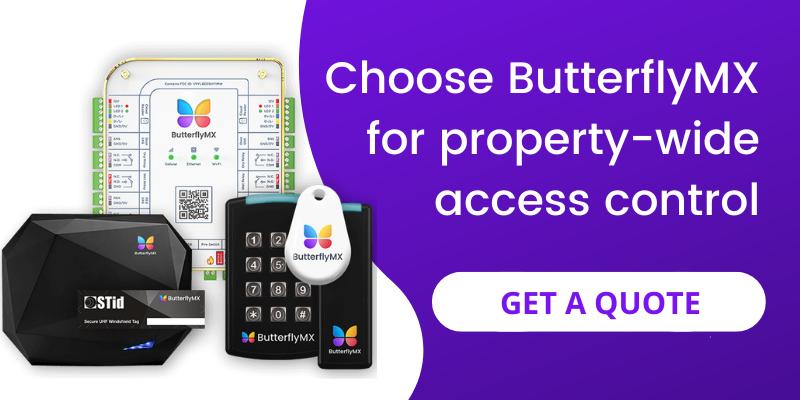Key takeaways
- A key fob is a popular entry method that grants tenants access to a property by holding it up to the fob reader.
- RFID copiers make it easy to copy a fob.
- Mobile access control systems empower tenants to use their smartphone as a key fob.

Disclaimer: ButterflyMX Access Control fobs and key cards are encrypted and cannot be copied with traditional scanners. Furthermore, ButterflyMX does not endorse the use of unauthorized RFID copiers, duplicators, or skimmers.
Keyless entry methods like key card and key fob systems have emerged as a popular way to grant seamless building access. However, because it’s so easy to copy a fob key, key fob cloning can pose a potential security risk.
Read this post to learn what a key fob is and how to copy an apartment key fob. Then, discover how to use a smartphone as a key fob. Finally, explore a modern alternative to key fobs.
This guide covers:
- What is a key fob?
- How easy is it to copy a key fob?
- Can I copy my key fob to my phone?
- A better alternative to key fob systems
- Copy fob key FAQs
What is a key fob?
A key fob is an RFID credential you present to a reader to access a property. Fobs are convenient for tenants because they can easily scan their fob instead of fumbling with traditional keys.
Additionally, key fobs are convenient for staff because they can revoke or grant access to key fobs remotely. As a result, they’re simple to issue to new tenants and easy to revoke for those who no longer need them.
However, key fobs can be easily copied or cloned. What’s more, key fobs and cards can demagnetize and stop working.
How easy is it to copy a key fob?
You can easily copy your key fob in five steps:
- Set up the RFID copier. Begin by turning on the device. Most copiers are compact, handheld tools that come with simple interfaces and clear instructions. Make sure the copier is powered, and familiarize yourself with the buttons labeled “Read” and “Write.”
- Read the original key fob. Hold the key fob you wish to duplicate close to the scanner on the copier. The fob must be positioned within the device’s reading range, which is typically about 1-3 inches, depending on the copier model. Then, press the “Read” button. The copier will scan the fob’s RFID frequency and data.
- Prepare the blank key fob. Replace the original key fob with a blank RFID tag or key fob. Blank fobs are widely available online and are compatible with most RFID copiers.
- Write the data onto the new fob. Now, press the “Write” button on the copier to transfer the data captured from the original key fob onto the blank one. Similar to the reading process, the copier will beep or flash to indicate that the transfer was successful.
- Test the newly duplicated key fob. Lastly, test the cloned key fob on the intended access point. If the key fob duplication is successful, the new fob will perform just like the original.
Pro tip: You should avoid buying a generic key fob copier as most key fobs are encrypted. To ensure you have a key fob copier that will successfully copy your key fob, be sure to contact the manufacturer for an authorized copier.

Can I copy my key fob to my phone?
No, you can’t copy a door or gate key fob to your phone. However, you can purchase an RFID sticker and attach it to your phone to use it as a key fob.
Alternatively, mobile access control systems make using a smartphone as a keyless entry method easy.
Can I use my iPhone as a key fob?
Yes, with a mobile access control system, you can use your smartphone as a key fob to enter doors, gates, and other access points. What’s more, ButterflyMX delivers a modern access control system that utilizes smartphone-based access that rivals traditional key fob and key card systems.
Learn how program ButterflyMX key cards and fobs:
A better alternative to key fob systems
If you’re concerned with the pitfalls of key cards and fobs, smartphone-based access control systems can be a better alternative to simplifying building entry.
What’s more, with over 40,000 five-star ratings, ButterflyMX offers a mobile access control solution that makes opening entry points with smartphones easier than ever.
Here’s how ButterflyMX makes property-wide access simple
- Video Intercom. Launch two-way video calls for seamless and secure communications with visitors. Moreover, it enhances security with a 156° wide-angle camera, making it easy to see guests with minimal blind spots.
- Delivery passes. Streamline access for couriers so they can securely drop off parcels and deliveries without a tenant needing to be present.
- Visitor Passes. For your convenience and peace of mind, share Visitor Passes that expire after an allotted period with visitors. Moreover, you can add or revoke access to these digital keys at any time.
- Audit logs. View easily accessible time and date-stamped photos of all entry events. This way, you’ll always know who’s accessing your property.
- Keypads. A ButterflyMX Keypad allows you to control, manage, and restrict access to shared amenity spaces, garages, and sensitive areas. Tenants no longer need a key fob to access these areas; they only need their smartphone or PIN for easy access.
- Smart lock integrations. ButterflyMX is compatible with more than 80 smart lock models, making it simple and convenient to open any access point with a smartphone. Your tenants will enjoy this feature over key fobs as they can lock and unlock their doors from anywhere.
- Multiple credentials. With ButterflyMX, you aren’t limited to just one credential. You can use key cards and fobs, swipe-to-open mobile entries, PIN codes, and Visitor Passes to enhance access anywhere on your property.
What’s more, using a smartphone as your primary entry method makes key fob cloning less likely. So, mobile access control systems are more secure while seamlessly granting access to tenants and visitors.
Copy fob key FAQs
- Is copying fobs illegal?
- How much does it cost to copy a fob key?
- Can a locksmith duplicate a key fob?
- Are key fobs programmed?
- What is the difference between an RFID and NFC key fob?
Is copying fobs illegal?
No, it’s not illegal to copy a fob key if the original key fob belongs to you. However, copying fobs can lead to unauthorized users potentially accessing your property.
Additionally, there are ethical and security considerations. While copying your own fob for personal or tenant use is typically acceptable, creating unauthorized duplicates can pose a significant security risk and may lead to penalties if unauthorized copies are discovered.
How much does it cost to copy a fob key?
The cost of duplicating a key fob depends on the method and service provider you choose. For example, if you hire a professional fob key copying company, you can expect to pay anywhere from $150 to $500.
The price can vary based on the following factors:
- Type of key fob – whether it’s basic or encrypted.
- Service provider – depending on DIY or specialized locksmith.
- Location – cities and regions can have an impact on locksmith pricing.
Can a locksmith duplicate a key fob?
Some locksmiths don’t always have the equipment necessary to read and replicate RFID or NFC key fob data. However, some modern locksmiths have adapted to the demand for key fob duplication and now offer these services. They often carry RFID copiers and blank fobs, allowing them to duplicate basic RFID keys.
Are key fobs programmed?
Yes, key fobs are programmed and encrypted with a unique ID code during manufacturing. As a result, each key fob is completely distinct and can’t be used to open access points that they’re not authorized to open.
What is the difference between an RFID and NFC key fob?
The main difference between RFID and NFC key fobs is that RFID key fobs are usually only capable of one-way communication. In contrast, NFC key fobs are capable of two-way communications. As a result, NFC key fobs are more complex and store more data than RFID models.







